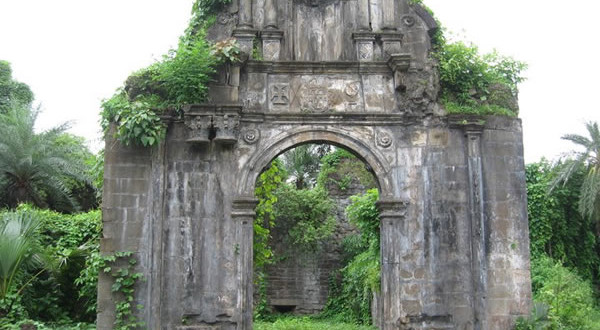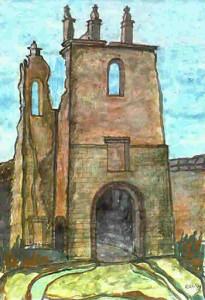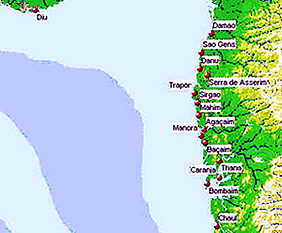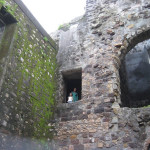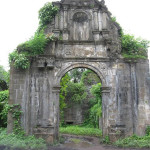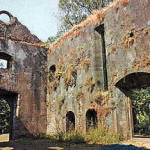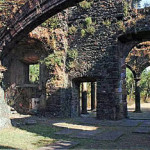This post is also available in:
![]() Português
Português
Written by Marco Ramerini. English text revision by Dietrich Köster.
Bassein-Vasai (Baçaim) is situated at about 70 kilometers north of Bombay on the Arabian Sea. It lies on an island at the mouth of a river and was thanks to this position easily defensible. The city, which belonged to the Kingdom of Cambay, was a very important one before the Portuguese conquest. The sources of wealth of Bassein (Baçaim) were: the horse trade, fishing, the salt, the timber, the stone quarry (basalt, granite) and the shipyards. In those days the city was situated in the center of a wealthy agricultural district, which yielded rice, betel, cotton, sugar-cane and more.
In 1528 Captain Heytor de Silveira captured and burnt the city of Bassein. After this the Lord of Thana submitted voluntarily as tributary to Portugal. In 1532 the Portuguese newly attacked Bassein and after a weak resistance they entered the fort and destroyed it. The towns of Thana, Bandora, Mahim and Bombaim were put under tribute. On 23 December 1534 the Sultan of Gujarat ceded by treaty Bassein with its dependencies (Salcete, Bombaim, Parel, Vadala, Siao, Vorli, Mazagao, Thana, Bandra, Mahim, Caranja) to Portugal.
In 1535 a Feitoria (Agency) and the Igreja de Nossa Senhora da Vida were built. In the same year the Sultan of Gujarat assaulted the city; for this reason in 1536 a fortress was built, around which the Portuguese town flourished. In 1540 the “Confraria da Misericórdia was founded”. In 1547 the Franciscans founded the Convent and the Church of Santo António and the Igreja Matriz de São José.
In 1548 St. Francisco Xavier stayed in Bassein and a portion of the Indian population was converted to Christianity. In 1549 the Jesuits built the Igreja do Sagrado Coração de Jesus. Later in 1561 they began to build their large College. In 1556 the Portuguese occupied the mountain “Serra de Açarim” and the fort of Açarim/Asserim and that of Manora were occupied in the vicinity.
A small fort was built at Caranja. On Salcete (Salsette) island 9 churches were built: Nirmal (1557), Nossa Senhora dos Remédios (1557), Sandor (1566), Agashi (1568), Nandakal (1573), Papdy (1574), Pale (1595), Manickpur (1606), Nossa Senhora das Merces (1606). In 1559 Damão was occupied and in the same year the fort of Bulsar was put under Portuguese control, but was already abandoned in 1560.
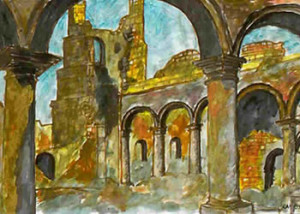
Baçaim, the ruins of the cloister and the tower of the Franciscan Church of Santo António, watercolor by Roberto Ramerini
In 1564 the Church of São Gonçalo was built by the Dominicans. In the second half of the 16th century the construction of a new fort had started and the whole town was surrounded by town walls with 10 bastions. The design of the fortress and of the bastions was inspired by the Italian Renaissance fortifications. In 1581 the Jesuits built the Igreja de Nossa Senhora da Graça and finally the Augustinians built the Igreja de Nossa Senhora da Anunciada in 1596.
Baçaim was known during the Portuguese period for the refinement and wealth of its buildings and palaces and for the beauty of its churches. The Northern Province included a territory, which extended as long as 100 kilometers on the coast, between Damão and Bombaim and in some places extended 30-50 kilometers towards the interior. It was the most productive Indian area under Portuguese rule. In defence of the Province were built several forts. The most important ones were in Damão, Damão Pequeno, Sao Gens, Danu, Serra de Asserim, Trapor, Sirgao, Mahim, Agaçaim (Ilhas das Vacas), Manora, Baçaim, Thana (Santa Cruz, Passo Seco, Baluarte do Mar), Bombaim and Caranja. At the end of the 17th century Baçaim reached the peak of its glory days. In 1611 a mint or “Casa da Moeda” was established in Baçaim.
In 1615 a triangular fort was built in Damão Pequeno (near Damão), which was named fort of São Jerónimo. In 1634 Baçaim numbered a population of 400 Portuguese families, 200 Christian Indian families and 1,800 slaves. The town, in case of enemy attack, numbered about 2,400 men as defenders.
On 23 June 1661 a Marriage Treaty between England and Portugal handed over to the British the port and the island of Bombaim (Bombay). The Portuguese governor of Bombaim refused to give up the island. After a long diplomatic skirmish Bombaim was ceded to the English on 18 February 1665, but without any of its dependencies.
In 1674 Baçaim numbered 2 colleges, 4 convents and 6 churches. In 1685 the Church of Nossa Senhora da Saúde was founded by the Knights Hospitallers of St. John. The decline of the Portuguese power in the Orient and the transfer of Bombaim (Bombay) to the British in 1665 weakened Baçaim. The city was attacked many times by the Mahrattas.
Notwithstanding this, in 1719 the province of Baçaim numbered still about 60.000 inhabitants, of these 2,000 were Portuguese and 58.000 were Christian Indians. In 1720 one of the ports of Baçaim, Kalyan, was conquered by the Mahrattas, and in 1737 they also took possession of Thana and of all the forts on Salcete island and the forts of Parsica, Trangipara, Saibana, the Ilha das Vacas, Manora, Sabajo, the hills of Santa Cruz and Santa Maria.
The only places in the Northern Province, which now remained with the Portuguese were Chaul, Caranja, Bandora, Versova, Baçaim, Mahim, Quelme, Seridao (Sirgao), Danu, Asserim, Trapor, and Damão. In November 1738 the Mahrattas captured the fort of Danu and on 20 January 1739 Mahim capitulated. The loss of Mahim was speedily followed by the capture of the forts of Quelme, Seridao, Trapor, and Asserim (13 February 1739). On 28 March 1739 the island and the fortress of Caranja, were also lost. This was the prelude to final loss of the city, indeed, in February 1739 the Mahrattas attacked Baçaim and after a desperate resistance the last Portuguese defenders surrendered on 16 May 1739. The Portuguese left Baçaim on 23 May 1739.
After 205 years of uninterrupted Portuguese rule Baçaim (now under the Mahrattas) was progressively neglected and the neighbouring English Bombay, took its place. During the war against the Mahrattas (1737-1740) the Portuguese lost, besides Baçaim, eight cities, four main ports, twenty fortresses, two fortified hills, the island of Salcete (Salsette) with the city and the fortress of Thana, the “Ilha das Vacas”, the island of Karanjà (Juem) and 340 villages. The losses amounted to nearly the whole of the Northern Province, only the town of Damão was held.
VASAI (BASSEIN): THE REMAINS OF A PORTUGUESE CITY-FORTRESS IN INDIA
Vasai (Bassein) is located in Thane District, 70 km north of Mumbai (Bombay). The city is located on the north bank of the Vasai Creek, being a part of the estuary of the Ulhas River. Taking a passenger train for Surat via Dadar from Bombay Central get down at Vasai Road (Bassein Road) station. The remains of the fort can be reached by bus or taxi from the Vasai railway station (11 km).
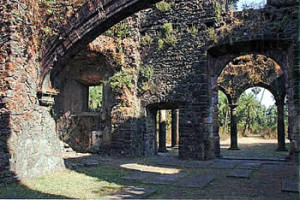
Cloister of the Franciscan Igreja de Santo António. Vasai, Bassein, Baçaim. Author and Copyright Sushant Raut
Of all the Portuguese forts still existing in India, Baçaim (today Vasai), is one of the most imposing. Today Baçaim is a tangle of ruins, the city has, still well preserved, his imposing boundary walls with his two access doors (“Porta do Mar” and “Porta da Terra”) and his 10 bastions.
Scattered inside the walls there are the ruins of numerous town-houses and churches, among other things: the church and the convent of the Dominicans, the Franciscan Igreja de Santo António (with numerous Portuguese tombstones, the remains of the cloister and the ruins of the bell-tower), the Igreja de Nossa Senhora da Vida, the church and convents of the Augustinians, the “Camara” palace, the Misericórdia, the Igreja Matriz de São José, the ruins of the Jesuits church and convent. Well preserved are also the remains of the old citadel of São Sebastião.
- Vasai, Bassein, Baçaim. Author and Copyright Sushant Raut
- Vasai, Bassein, Baçaim. Author and Copyright Sushant Raut
- The entrance Gate to the citadel of the fortress. Vasai, Bassein, Baçaim. Author and Copyright Sushant Raut
- Interior of the Igreja de Nossa Senhora da Vida (1535), the oldest church of Baçaim. Vasai, Bassein, Baçaim. Author and Copyright Sushant Raut
- Cloister of the Franciscan Igreja de Santo António. Vasai, Bassein, Baçaim. Author and Copyright Sushant Raut
BIBLIOGRAPHY:
– Albuquerque, Teresa “Epigraphy of Bassein” In: Mare Liberum, Revista de História dos Mares N° 9, ” VII Seminário internacional de História Indo-Portuguesa, Goa 1994″, pp. 311-320, 1995, Lisbon, Portugal.
– Baptista, Elsie W. “The East Indians: Catholic community of Bombay, Salsette and Bassein” 255 pp. Publications of the Anthropos Institute N° 3, The Bombay East Indian Association, 1967, Bandra, Bombay.
– Barros, Joseph de “A presença portuguesa em Baçaim: sua génese geo-histórica” In: Mare Liberum, Revista de História dos Mares N° 9, ” VII Seminário internacional de História Indo-Portuguesa, Goa 1994″, pp. 41-47, 1995, Lisbon, Portugal.
– Borges, Charles J. “Jesuit economic interests in the Portuguese Province of the North till the mid-18th century” In: Mare Liberum, Revista de História dos Mares N° 9, ” VII Seminário internacional de História Indo-Portuguesa, Goa 1994″, pp. 49-56, 1995, Lisbon, Portugal.
– Bras, A. Fernandes “Armas e inscrições do forte de Baçaim” 282 pp. maps, ill. Academia Portuguesa da História 1957 Lisboa, Portugal. The complete list and also the descriptions of the inscriptions present in Baçaim fort.
– Couto, Dejanirah “Em torno da concessão e da fortaleza de Baçaim 1529-1546″ In: Mare Liberum, Revista de História dos Mares N° 9, ” VII Seminário internacional de História Indo-Portuguesa, Goa 1994″, pp. 117-126, 1995, Lisbon, Portugal.
– Couto, Dejanirah “A fortaleza de Baçaim” In: “Oceanos” n° 28 Oct/Dec. 1996 pp. 105-118 – Couto, Dejanirah “Baçaim a capital do norte” In: “Oceanos” n°19-20, Sep/Dec. 1994 pp. 258-266
– Cunha, J. Gerson da, “The origin of Bombay” 368 pp Asian Educational Services, 1993 (1900), New Delhi, India.
– Cunha, G. da “Notes on the history and antiquities of Chaul and Bassein” 278 pp. Map & ills. 1993 (1876), Bombay, India.
– Gaspar Rodrigues, Vitor Luis “A organização militar da Província do Norte durante o séc. XVI e princípios do séc. XVII” In: Mare Liberum, Revista de História dos Mares N° 9, ” VII Seminário internacional de História Indo-Portuguesa, Goa 1994″, pp. 247-265, 1995, Lisbon, Portugal.
– Hull, Ernest R. “Bombay mission-history, with a special study of the padroado question (1534-1858)” ? vii+493 pp. 7 color maps Bombay Examiner Press, 1927,
– Leão, M. C. “A Província do Norte do Estado da India” 223 pp. several maps and illustrations, Instituto Cultural de Macau, 1996, Macau.
– Martires Lopes, Maria de Jesus dos “Aspectos da política religiosa na província do Norte, em setecentos” In: Mare Liberum, Revista de História dos Mares N° 9, ” VII Seminário internacional de História Indo-Portuguesa, Goa 1994″, pp. 175-179, 1995, Lisbon, Portugal.
– Meersman, A. “The Franciscans in Bombay. History of the Franciscans in the territory comprised within the boundaries of the present archdiocese of Bombay” xvii+279 pp. 1957, Bangalore, India.
– Oliveira e Costa, Joao Paulo “Simão de Andrade fidalgo da Índia e capitão de Chaul” In: Mare Liberum, Revista de História dos Mares N° 9, ” VII Seminário internacional de História Indo-Portuguesa, Goa 1994″, pp. 99-111, 1995, Lisbon, Portugal.
– Pereira, A. B. de Bragança “Os portugueses em Baçaim” ? 220 pp Sep. de: O Oriente Português Tip. Rangel 1935 Bastorá In: Oriente Portugues N° 7/8/9 pp. 97-313
– Rossa, W. “Indo-Portuguese cities” 117 pp. illust. Comissão Nacional para as Comemorações dos Descobrimentos Portugueses 1997 Lisboa Very interesting descriptions of the Portuguese town of Goa, Chaul, Baçaim, Damao, Diu, Cochin.
– Santos, Isau “A cedência de Bombaim aos Ingleses” In: Mare Liberum, Revista de História dos Mares N° 9, ” VII Seminário internacional de História Indo-Portuguesa, Goa 1994″, pp. 267-290, 1995, Lisbon, Portugal.
– Shirodkar, P. P. “Bombay and the Portuguese impact and influences with special reference to etymology” In: Mare Liberum, Revista de História dos Mares N° 9, ” VII Seminário internacional de História Indo-Portuguesa, Goa 1994″, pp. 291-301, 1995, Lisbon, Portugal.
– Soeiro de Brito, Raquel “Goa e as praças do Norte” 196 pp Junta de Investigaçoes do Ultramar, 1966 (CNCDP 1998), Lisbon, Portugal.
– Varela Gomes, Paulo and Rossa, Walter “O primeiro territorio. Bombaim e os Portugueses” In: “Oceanos” n° 41, 2000.
– Velinkar, Joseph “Early Jesuit presence in Bassein” In: Mare Liberum, Revista de História dos Mares N° 9, ” VII Seminário internacional de História Indo-Portuguesa, Goa 1994″, pp. 305-310, 1995, Lisbon, Portugal.
This post is also available in:
![]() Português
Português
 Colonial Voyage The website dedicated to the Colonial History
Colonial Voyage The website dedicated to the Colonial History
